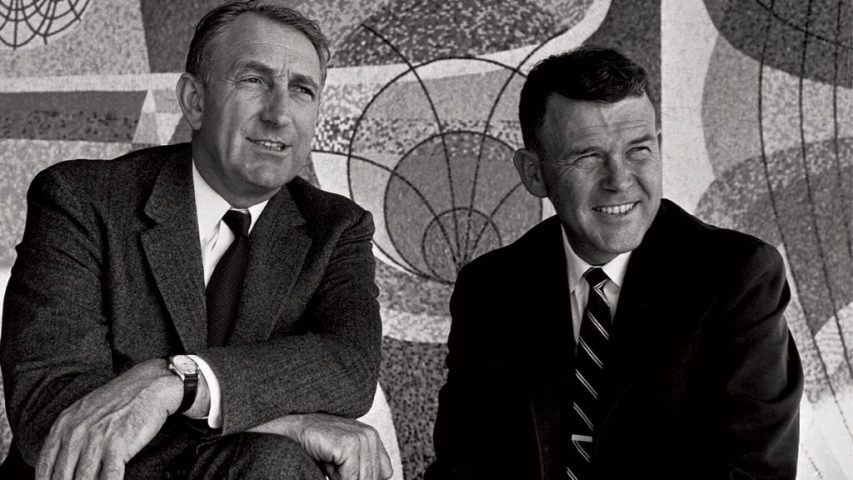Printing pioneers – Hewlett & Packard

How to prepare a document for a print shop
September 18, 2019
Tips for Printing the Best Images
September 26, 2019
HP transformed the way we buy our ink with its HP Instant Ink service, launched in 2013. But this innovation was just the latest revolution in the company’s long history as a Silicon Valley pioneer. And that’s a story that all began with the company’s founders Bill Hewlett and Dave Packard.
Bill Hewlett and Dave Packard were students at Stanford University during a pivotal time for Palo Alto. In the 1930s, the hillsides of Silicon Valley were dedicated to orchards rather than the campuses of high-tech firms, but the seeds of a burgeoning electronic and radio industry were already planted.
At the birth of Silicon Valley
The graduate course in radio engineering run by professor Fred Terman incorporated visits to some of the local firms, including Litton Industries and Eitel-McCullough. Terman wanted to develop a thriving tech scene in the area which could foster the cross-fertilization of ideas and talent and he encouraged his students to set up shop nearby.
This led to Hewlett and Packard establishing a workshop in a now-legendary garage in the backyard of the house at 367 Addison Avenue in Palo Alto. Today, HP offers its best customers the opportunity to dine inside this famous landmark but, in 1938, the duo used the garage to test out their ideas for exercise machines and foul-line signals for a local bowling alley.
Packard lived in the house with his wife Lucile, while Hewlett slept in a small shack to the side of the garage. From this humble set-up, and with the help of fellow Stanford alumnus Charlie Litton, Hewlett and Packard pioneered a new audio oscillator that could be used to design, produce and maintain audio equipment. It caught the eye of the Disney Corporation, which secured a future for HP and prompted a move up from the fabled garage.
In the autumn of 1939, the business moved to new office space near the corner of Page Mill Road and El Camino Real – two roads now at the heart of Silicon Valley. Before long, it would move again to a new industrial park established by their former professor, Fred Terman. Today, Stanford Research Park is still home to HP.
Innovating in management philosophy and printing
HP benefitted from military spending during WWII, but lost one of its founders – Hewlett spent the war serving in the Army Signal Corps. Rather than take a vast CEO salary, Packard maintained his salary at the same rate of Hewlett’s military pay, choosing instead to reward the company workers through a generation revenue-sharing compensation plan.
This approach to management led to HP gaining a winning reputation through the 1950s and 1960s. At company barbeques, Hewlett and Packard would serve as grill masters. In the office, the pair championed an “open door” policy. The company also has the dubious honour of creating the office cubicle.
It was their open door approach to management that enabled new ideas to flourish, including Richard Hackborn’s idea for HP’s printer group. This division rose to pre-eminence in the 1980s thanks to the launch of new inkjet and laser printers from 1984 onwards. HP’s launch of its low-cost ThinkJet inkjet printer in 1984 heralded the beginning of the end for the noisy dot-matrix printer that had prevailed until then.
The founders’ legacy
Commentators have suggested that since the founders finally left the company, HP simply got too big to innovate in the way that had driven its initial success.
Through the early years of the twenty-first century, HP certainly seemed to have lost its way with a series of poor management decisions and five different CEOs over this time. It wasn’t until Meg Whitman took the reins in 2011 – the third CEO in as many years – that HP began to reclaim its status as one of Silicon Valley’s elite.
Whitman had already established her Silicon Valley credentials as CEO at e-Bay – guiding it from a 30-person start-up to publicly listed behemoth during her 1998 – 2007 tenure. She brought HP’s printer and PC groups back together again, laid off some 85,000 employees, split the business into two different enterprise and personal computing entities – Hewlett Packard Enterprise and HP Inc, respectively – and increased R&D spending.
She is determined to return the iconic business to its founders’ core principles, in 2016 telling the Harvard Business Review: “It’s very hard to kill founder DNA, and that’s a good thing for HP. Dave Packard and Bill Hewlett have been gone from the company for many years. There have been many acquisitions, many changes. But the core values still show through: the ability to do incredible innovation; a passion for customer support and service; giving back to the community. Dave and Bill were social responsibility leaders and environmentalists before those were even terms. We may have fallen on some hard times, but we’re going to double down on those values.”



